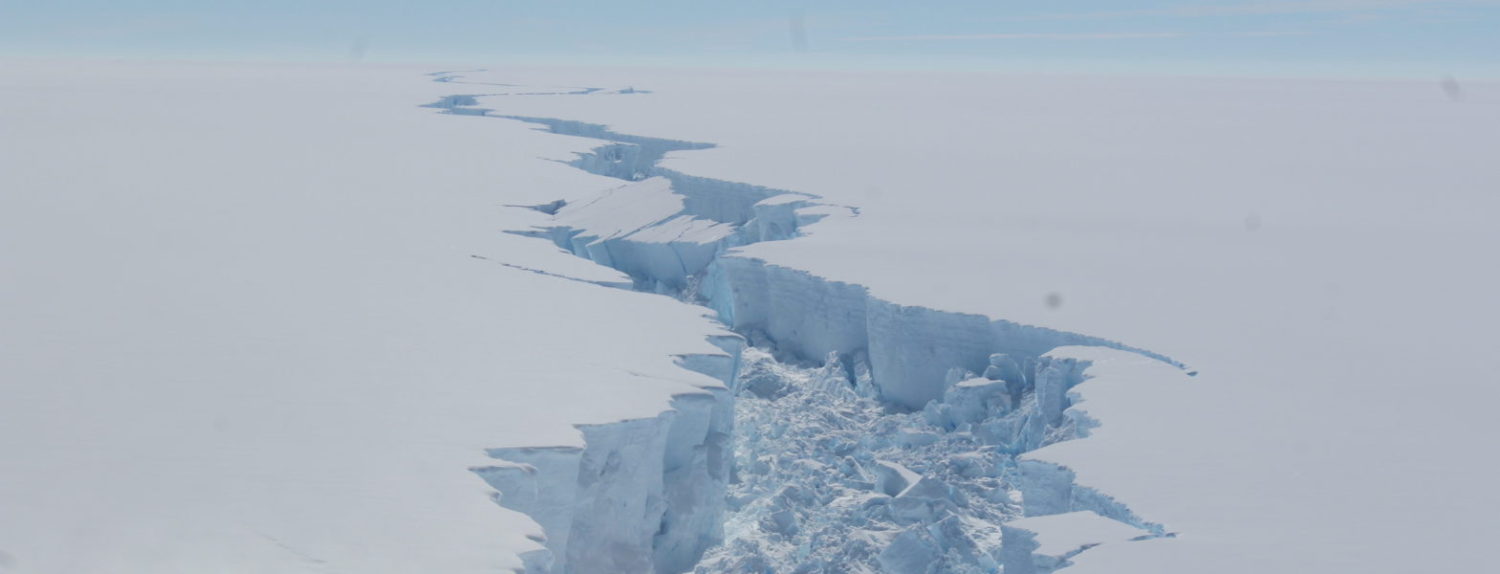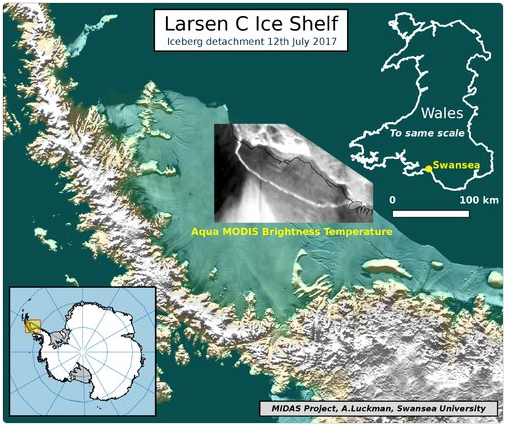Huge Antarctic iceberg finally breaks free
by the British Antarctic Survey
July 12th, 2017
After months of ‘hanging by a thread’ a vast iceberg the size of Norfolk has finally broken off Antarctica’s Larsen C Ice Shelf. Around 30 metres of this 190m thick block of ice sits above the sea surface.
Scientists now have opportunities to study the stability of the remaining ice shelf, as well as understanding how new biological communities might occupy the newly exposed ocean and underlying seabed areas.
At more than 6,000 km² in area, the new iceberg represents more than 10% of the ice shelf. This calving is dramatic but normal in the life cycle of an ice shelf. However, scientists will be looking to determine if loss of the iceberg will have any impact on the stability of the remaining ice shelf.
Throughout the Antarctic winter research teams, led by the University of Swansea and including researchers from British Antarctic Survey (BAS), monitored the progress of a 170 km long ice rift in the ice shelf using the European Space Agency (ESA) Copernicus Sentinel-1 satellites.
According to BAS remote sensing analyst Andrew Fleming, the satellite images have been critical for research planning.
He says: “This story has just got even more interesting. Our glaciologists will now be watching closely to see whether the remaining Larsen C Ice Shelf becomes less stable than before the iceberg broke free, and our biologists will be keen to understand how new habitats formed by the loss of the ice are colonised.”
Professor David Vaughan, glaciologist and Director of Science at British Antarctic Survey (BAS), said:
“Larsen A and B ice shelves, which were situated further north on the Antarctic Peninsula, collapsed in 1995 and 2002, respectively. This resulted in the dramatic acceleration of the glaciers behind them, with larger volumes of ice entering the ocean and contributing to sea-level rise. If Larsen C now starts to retreat significantly and eventually collapses, then we will see another contribution to sea level rise.

The calving event has potential opportunities for new studies of open ocean and seabed habitats. According to Drs Phil Trathan and Susie Grant of the BAS Conservation Biology team this calving event will provide unique scientific opportunities for understanding how new biological communities develop and how new species occupy the newly exposed area.
Dr Grant, a marine bio-geographer at BAS says:
“At the 2016 meeting of the Commission for the Conservation of Antarctic Marine Living Resources (CCAMLR) there was international agreement that any newly exposed areas of ocean following ice shelf retreat or collapse could be automatically protected and designated as a Special Area for Scientific Research.”
Dr Trathan, Head of Conservation Biology adds:
“For this to happen the new environment must meet the specific criteria agreed by CCAMLR. If designated, this would restrict commercial fishing activities and provide a valuable opportunity for studying the new habitats created, including how species colonize the area and new communities develop.”
British Antarctic Survey scientists and their UK and international research collaborators have debated the cause of ice thinning on Larsen Ice Shelf for a decade. In 2015 they published an international study in the journal The Cryosphere. The research team combined satellite data and eight radar surveys captured during a 15-year period from 1998–2012. They found that Larsen C Ice Shelf lost an average of 4 metres of ice, and had lowered by an average of one metre at the surface. The study revealed that the ice shelf is thinning from both its surface and beneath, suggesting warming air temperatures and warmer ocean currents play a role. This recent finding was an important step forward in assessing Antarctica’s likely contribution to future sea-level rise.
Researchers from the UK-based MIDAS project, led by Swansea University, have reported several rapid elongations of the Larsen Ice Shelf rift in recent years.
Satellite technology
Scientists knew the calving event was imminent because of developments in satellite technology which have enabled them to watch the rift even during darkness and bad weather. The European Union Copernicus programme has developed a new two-satellite constellation, called Sentinel-1, operated by the European Space Agency, which has become indispensable for watching ice movement in the Polar Regions.
This pair of satellites is equipped with radar, and routinely collects and delivers images of the coast of Antarctica. By contrast to optical instruments the Sentinel-1 acquire images of the ice sheet under all weather conditions, even when Antarctica is shrouded in darkness.
Is this calving event caused by climate change?
Professor Vaughan says: “There is little doubt that climate change is causing ice shelves to disappear in some parts of Antarctica at the moment. We see no obvious signal that climate warming is causing the whole of Antarctica to break up. However, around the Antarctic Peninsula, where we saw several decades of warming through the latter half of the 20th century, we have seen these ice shelves collapsing and ice loss increasing.
“There are other parts of the Antarctica that which are losing ice to the oceans but those are affected less by atmospheric warming and more by ocean change.
“Larsen C itself might be a result of climate change, but, in other ice shelves we see cracks forming, which we don’t believe have any connection to climate change. For instance on the Brunt Ice Shelf where BAS has its Halley Station, there those cracks are a very different kind which we don’t believe have any connection to climate change.”
An ice shelf is a floating extension of land-based glaciers which flow into the ocean. Because they already float in the ocean, their melting does not directly contribute to sea-level rise. However, ice shelves act as buttresses holding back glaciers flowing down to the coast.
During the recent Antarctic field season, a BAS glaciology research team was on Larsen C using seismic techniques to survey the seafloor beneath the ice shelf. Because a calving looked likely, as a precaution the team was unable to set up camp on the ice as usual. Instead they made daily field trips by aircraft supported from Rothera Research Station.
Antarctic Treaty – newly exposed areas through ice-shelf collapse
In 2010 an ‘Antarctic Treaty Meeting of Experts on Implications of Climate Change for Antarctic Management and Governance’, made a number of recommendations, including:
Recommendation 26: The ATME recommends, recognising the responsibilities of and need to coordinate with CCAMLR, that the CEP consider, and advise the ATCM accordingly, as to means by which automatic interim protection might be afforded to newly exposed areas, such as marine areas exposed through ice-shelf collapse.
Work to take this through CCAMLR was undertaken and led by scientists from BAS.
